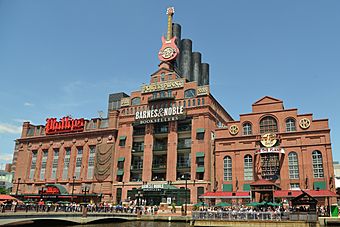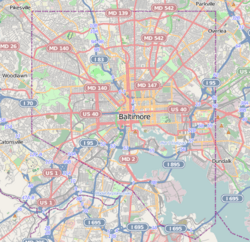Pratt Street Power Plant facts for kids
Quick facts for kids |
|
|
Pratt Street Power Plant
|
|

Power Plant in 2012, view from the west
|
|
| Location | 601 E. Pratt St., Baltimore, Maryland |
|---|---|
| Area | 1.4 acres (0.57 ha) |
| Built | 1900 |
| Architect | Baldwin & Pennington; Et al. |
| NRHP reference No. | 87000564 |
| Added to NRHP | April 9, 1987 |
The Pratt Street Power Plant is a historic building in downtown Baltimore, Maryland, USA. It used to be a big power station that made electricity for the city. Today, it's no longer a power plant. Instead, it has been changed into a cool place with shops, restaurants, and offices. It's also known as the Pier Four Power Plant or just The Power Plant. This important building was added to the National Register of Historic Places in 1987.
Contents
A Look Back: The Power Plant's Story
Building a Powerhouse
The Pratt Street Power Plant is a huge building, about 132 feet wide and 326 feet long. It's made of strong brick with fancy terra cotta decorations. Steel frames hold it all together. It was built a long time ago, between 1900 and 1909. The architects, Baldwin & Pennington, designed it with a classic, grand style called Neo-Classical. This building was super strong. It was one of only 11 buildings that survived the big Baltimore Fire of 1904!
Powering the City
This plant was very important for Baltimore. It was the main source of power for the United Railways and Electric Company. This company ran all the electric street railways, or trams, in the city. These trams helped people travel all over Baltimore and even opened up new neighborhoods.
Later, the plant also made steam for the Consolidated Gas, Electric Light and Power Company. This company is now known as the Baltimore Gas and Electric Company.
The power plant used coal to heat its boilers. Its location right on the Inner Harbor made it easy for ships to deliver coal. The harbor also provided water to cool down the equipment. Cold water was taken in from one side of the pier and warm water was sent out on the other.
By the 1970s, the equipment in the plant was old. It was used less and less. However, it was brought back to life during World War II to help make enough electricity for the war effort. Finally, the Baltimore Gas & Electric Company stopped using the plant in 1973.
What Happened Next: A New Life
After the power plant stopped making electricity, the building was empty for several years. Eventually, the City of Baltimore bought it. Since then, it has been completely changed and used for many different businesses. This is called "repurposing" a building.
The first attempts to reuse the building were not very successful. There was an indoor Six Flags theme park called Six Flags Power Plant from 1985 to 1989. Then, a dance club called P.T. Flagg's was there for a short time.
However, other projects have done much better! Some of the businesses that have been in The Power Plant include:
- The first ESPN Zone in the country, which opened in 1998.
- Hard Rock Cafe, which opened in 1997.
- Barnes & Noble, a bookstore that opened in 1998.
- Gold's Gym, a fitness center.
- Loft offices for businesses.
Maryland Art Place, a gallery that shows art from Maryland artists, is also located in the building. The Power Plant even gave its name to the nearby Power Plant Live! area, which is a popular spot for nightlife.
The Cordish Company, a big development company, has its main office on the sixth floor. They also developed the building next door, Pier IV, which has restaurants like Chipotle Mexican Grill.




